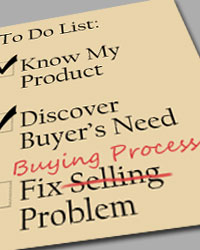 You know your solution. You understand your buyer’s need. You know how to sell. You understand the competition. You know how to price your solution, how to pitch it, how to run a presentation, how to follow up. You know the pitfalls, the follow-up procedures. Why aren’t you selling more then? Why aren’t prospects closing more?
You know your solution. You understand your buyer’s need. You know how to sell. You understand the competition. You know how to price your solution, how to pitch it, how to run a presentation, how to follow up. You know the pitfalls, the follow-up procedures. Why aren’t you selling more then? Why aren’t prospects closing more?
I recently got a call from a prospect who said all of the above. Yes, they know everything – and do whatever they need to do, and do it well. Why aren’t they closing more? This is the perennial problem for a sales professional. It makes no sense: sellers can see the problem – seen it hundreds of times. You know your solution fits. Perfectly. The buyer knows they need you. The buyer is ok with the price. You two have a great relationship. And then they disappear, with about 90% of the other prospects you’ve been nurturing.
It’s an age old problem, one I’ve been talking about for 20 years. But after the conversations I’ve had this week, I thought it might be time to review.
THE SALES MODEL ONLY MANAGES 10% OF THE BUYING JOURNEY
It’s not the fault of your solution. The problem is with the sales process. It merely handles a tiny part of the buyer’s decision making. They actually have a rigorous set of change management activities they must complete, among colleagues and departments (or family members), before they can consider making a purchase. I’ve written a whole book about this (Dirty Little Secrets: why buyers can’t buy and sellers can’t sell and what you can do about it). Let me share some insights (and then, if I’ve made some sense to you, go buy the book! or at least read the sample chapters).
- you are acting as if the buyer’s need/problem were an isolated event. Stop it. It’s not. It’s part of something larger that you aren’t privy to and that has sat there, functioning ‘well-enough’, for some time.
- if the buyer really believed they needed your solution they would have gotten it – or something like it – already.
- buyers don’t want your solution. They want to resolve a problem in the most efficient, effective way that creates the least disruption.
- understanding what the buyer needs is not going to help them make a buying decision, even if you’re right, and even if they need your solution.
- sellers can only understand that part of the ‘need’ that they can see or surmise. There is much more going on that is unseen, endemic, and visible only to insiders.
- whatever data you collect from technology does not give you what you need to help buyers navigate through their behind-the-scenes political issues.
- just because someone looks like a prospect and acts like a prospect doesn’t mean she’s a prospect.
- your problem is not a sales problem; it’s about what buyers need to go through with colleagues and business practices before they can decide to buy. You know how to sell. That’s not what is going on here. That’s not keeping the buyer from buying.
- if you hear yourself saying “That buyer is stupid” please consider that it isn’t the buyer who’s stupid.
- until or unless the buyer figures out how to manage all of the off-line, behind-the-scenes decisi0n issues they need to address amongst themselves and colleagues (and vendors and investors and and and) they will do nothing regardless of their need. They never need it as bad as you think they do. They have work-arounds.
- to make any change or purchase, the buyer must go through some private stuff that you can’t be a part of so long as you continue operating out of a sales mind. They’re going to go through this with you or without you: might as well be with you. But the sales model doesn’t offer skills to help this part of the decision journey.
- buyers buy using their buying patterns, not your selling patterns. Buying is a change management problem, not a solution choice activity. Choosing a solution is the very last thing that happens.
- buyers don’t even know how to make sense of your solution data until they are far into the choice process.
- with the capabilities of technology the sales job is doomed. Unless you add some new skills, what you are doing is not going to be needed for much longer.
Did I get your attention? Great. Because I can fix all of the above. Buy my book. Have me do a keynote for your company. Have me come and train. License my material. Get some of the Learning Accelerators. But whatever you do, do it while you still have a job.
sd





3 thoughts on “You have a buying process problem, not a selling problem”
I think this is brilliant. What most Organizations really fail to realize is that enterprise solutions come with great risk and costs then is even determined by an effective ROI model—ones traditionally supplied by the VENDOR!!! Change Management is an enormous component of any major investment. To ignore this is to demonstrate a dislike of doing things on purpose and an affinity for “rolling the dice”.
Pingback: Marketing: what, exactly, is it now? | Sharon-Drew Morgen
Pingback: Are Salespeople Going the Way of Telemarketers? | Sharon-Drew Morgen